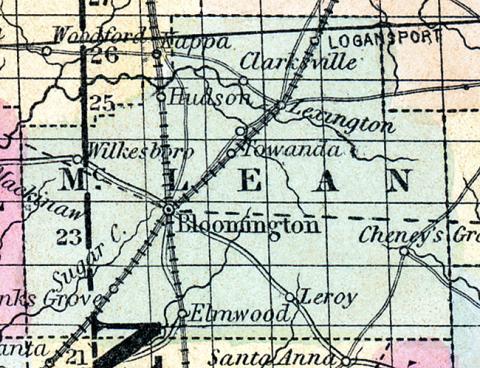McLEAN COUNTY, situated in the central part of Illinois. Area, 1,296 square miles. Seat of justice, Bloomington. Pop. in 1840, 6,565; in 1850, 10,163. (Fanning's, 1853)
McLEAN COUNTY Is situated in the central part of the state, and has an area of 1260 square miles. The county originally embraced an area of 42 by 58 miles, since which time portions of it have been taken off to form the counties of Livingston, Woodford, and De Witt, leaving it in its present form. It was formed in 1831 through the efforts and under the supervision of James Allen, Esq., who donated 30 acres of land as a county seat, and the same on which the city of Bloomington now stands. The present court house was erected in 1836, previous to which time the various courts of the county were held in a small room in Mr. Allen's cabin. The county is drained by Mackinaw, Kickapoo, Salt, and Sugar creeks, all rising within its limits. The surface consists mostly of open plains or prairies, the soil is deep and very fertile, producing naturally an abundance of gross, and a great variety of most beautiful flowers. Corn, wheat, oats, hay, and pork are the staples. It contains a large number of churches, the state normal institution, two colleges, and several schools of a higher order, beside those denominated public. A number of newspapers are also issued within its limits. There are about 2,200 pupils attending the various schools and colleges. Beds of stone coal, and building stone are found in several places. The county is intersected by the St. Louis, Alton and Chicago, and Illinois railroads, which cross one another at Bloomington. Named in honor of Hon. John McLean, member of congress. Population, about 26,000. County Judge, A. J. Merriman. Sheriff, J. H. Morse. (Hawes' Illinois State Gazetteer...,1859)

